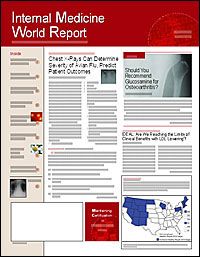Dyslipidemia Increases Hypertension Risk
Dyslipidemia is associated with an increased risk for the subsequent development of hypertension in men, according to results of a new study published in Hypertension (2006;47: 45-50).
"Just as dyslipidemia predisposes to atherosclerosis in the coronary arteries, it may also promote atherosclerosis and endothelial damage throughout the body," lead investigator Ruben Halperin, MD, told IMWR.
Dr Halperin noted that endothelial damage may be associated with activation of the sympathetic nervous system and increased production of catecholamines, subsequently increasing heart rate and blood pressure (BP).
His group examined data from 3110 men enrolled in the Physicians' Health Study who were followed for a mean of 14.1 years. Baseline measurements of total cholesterol and high-density lipoprotein cholesterol (HDL-C) levels were recorded.
All participants completed questionnaires at 6 months and annually thereafter. Incident hypertension was defined as either the initiation of antihypertensive treatment, systolic BP >=140 mm Hg, or diastolic BP >=90 mm Hg during follow-up.
A total of 1019 men developed hypertension during follow-up. The mean total cholesterol level at baseline was 210.5 mg/dL in the normotensive group and 217.7 mg/dL in the hypertensive group (P <.001).
At baseline, those in the lowest total cholesterol quintile were younger, leaner, less likely to smoke, more likely to exercise, and consumed less alcohol compared with the other quintiles. The multivariate-adjusted risk of developing incident hypertension was 23% higher among participants in the highest total cholesterol quintile as compared with those in the lowest quintile.
Baseline HDL-C levels were inversely associated with the risk of incident hypertension in age- and multivariate-adjusted models. The multivariate-adjusted risk of developing hypertension was 39% higher among those in the highest HDL-C quintile compared with those in the lowest total cholesterol quintile.
"There was a ?dose response,' with higher levels of total cholesterol and lower levels of HDL cholesterol associated with a higher risk of developing hypertension," Dr Halperin said.
The risk of developing hypertension was 69% greater in the age-adjusted model among those in the highest quintile of total cholesterol/HDL-C ratio compared with the lowest ratio quintile and 54% in the multivariate-adjusted model (both, P <.001 for trend). A similar trend was evident in the multivariate-adjusted model for high versus low levels of the 2 parameters (Table).
Hyperlipidemia appeared to predate the onset of hypertension by years, Dr Halperin and colleagues wrote. "There may come a time when the treatment of dyslipidemia becomes part of the treatment of hypertension or a tool for preventing hypertension in those at risk," Dr Halperin told IMWR.
